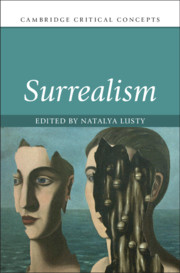Book contents
- Surrealism
- Cambridge Critical Concepts
- Surrealism
- Copyright page
- Contents
- Illustrations
- Notes on Contributors
- Acknowledgments
- Introduction: Surrealism’s Critical Legacy
- Part I Origins: Ideas/Concepts/Interventions
- Chapter 1 The Surrealist World
- Chapter 2 Psychoanalysis
- Chapter 3 Surrealism and the Demand of Politics
- Chapter 4 Modern Science
- Chapter 5 Surrealism and Dreams
- Chapter 6 Surrealism and Eros
- Part II Developments: Practices/Cultures/Material Forms
- Part III Applications: Heterodoxies and New Worlds
- Select Bibliography
- Index
Chapter 4 - Modern Science
from Part I - Origins: Ideas/Concepts/Interventions
Published online by Cambridge University Press: 23 July 2021
- Surrealism
- Cambridge Critical Concepts
- Surrealism
- Copyright page
- Contents
- Illustrations
- Notes on Contributors
- Acknowledgments
- Introduction: Surrealism’s Critical Legacy
- Part I Origins: Ideas/Concepts/Interventions
- Chapter 1 The Surrealist World
- Chapter 2 Psychoanalysis
- Chapter 3 Surrealism and the Demand of Politics
- Chapter 4 Modern Science
- Chapter 5 Surrealism and Dreams
- Chapter 6 Surrealism and Eros
- Part II Developments: Practices/Cultures/Material Forms
- Part III Applications: Heterodoxies and New Worlds
- Select Bibliography
- Index
Summary
The interest taken by Surrealists in alchemy has been well known since the late 1940s, but knowledge of their preoccupation with modern science is more recent. This chapter observes the Surrealist penchant for premodern, occultist epistemologies before focusing on their take up of modern physics in the early 1920s. The theory of relativity (1905 and 1915–16) and developments in quantum mechanics (1922–7) were then undergoing popularization. Apart from popular articles in newspapers/journals, this occurred partly through physicists’ own writings and partly through the philosophy of science. This chapter indicates the importance to Surrealism of the writings of the French philosopher of science, Gaston Bachelard. It also features a case study of the work of German physicist Pascual Jordan whose attempt to extend the findings of quantum mechanics to biology was known to Max Ernst and used by the Surrealists to justify the rejection of positivism. So modern physics became a means of retrospectively comprehending the Surrealists’ turn towards automatism and Ernst’s own natural history incursions. His response to Jordan’s writings offers an alternative way of reading his work.
- Type
- Chapter
- Information
- Surrealism , pp. 78 - 93Publisher: Cambridge University PressPrint publication year: 2021

